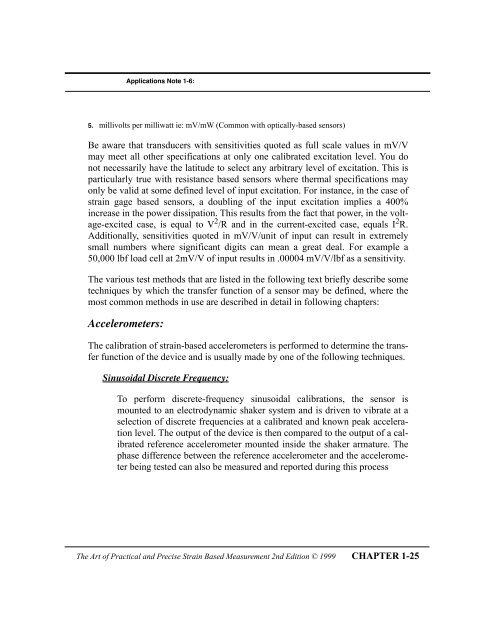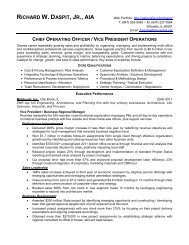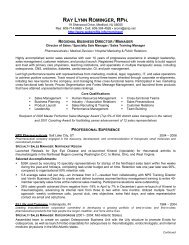The Art of Practical and Precise Strain Based ... - Webprofile.info
The Art of Practical and Precise Strain Based ... - Webprofile.info
The Art of Practical and Precise Strain Based ... - Webprofile.info
- No tags were found...
You also want an ePaper? Increase the reach of your titles
YUMPU automatically turns print PDFs into web optimized ePapers that Google loves.
Applications Note 1-6:5. millivolts per milliwatt ie: mV/mW (Common with optically-based sensors)Be aware that transducers with sensitivities quoted as full scale values in mV/Vmay meet all other specifications at only one calibrated excitation level. You donot necessarily have the latitude to select any arbitrary level <strong>of</strong> excitation. This isparticularly true with resistance based sensors where thermal specifications mayonly be valid at some defined level <strong>of</strong> input excitation. For instance, in the case <strong>of</strong>strain gage based sensors, a doubling <strong>of</strong> the input excitation implies a 400%increase in the power dissipation. This results from the fact that power, in the voltage-excitedcase, is equal to V 2 /R <strong>and</strong> in the current-excited case, equals I 2 R.Additionally, sensitivities quoted in mV/V/unit <strong>of</strong> input can result in extremelysmall numbers where significant digits can mean a great deal. For example a50,000 lbf load cell at 2mV/V <strong>of</strong> input results in .00004 mV/V/lbf as a sensitivity.<strong>The</strong> various test methods that are listed in the following text briefly describe sometechniques by which the transfer function <strong>of</strong> a sensor may be defined, where themost common methods in use are described in detail in following chapters:Accelerometers:<strong>The</strong> calibration <strong>of</strong> strain-based accelerometers is performed to determine the transferfunction <strong>of</strong> the device <strong>and</strong> is usually made by one <strong>of</strong> the following techniques.Sinusoidal Discrete Frequency:To perform discrete-frequency sinusoidal calibrations, the sensor ismounted to an electrodynamic shaker system <strong>and</strong> is driven to vibrate at aselection <strong>of</strong> discrete frequencies at a calibrated <strong>and</strong> known peak accelerationlevel. <strong>The</strong> output <strong>of</strong> the device is then compared to the output <strong>of</strong> a calibratedreference accelerometer mounted inside the shaker armature. <strong>The</strong>phase difference between the reference accelerometer <strong>and</strong> the accelerometerbeing tested can also be measured <strong>and</strong> reported during this process<strong>The</strong> <strong>Art</strong> <strong>of</strong> <strong>Practical</strong> <strong>and</strong> <strong>Precise</strong> <strong>Strain</strong> <strong>Based</strong> Measurement 2nd Edition © 1999 CHAPTER 1-25
















